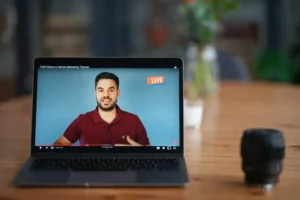You want to create your own video platform outside of YouTube, Vimeo, or other video portals? Not only do you need a smart concept and perseverance, but also the necessary infrastructure. We describe the advantages, challenges, and offer tips for setting up your own video portal.
Table of contents
+- What exactly is a video platform?
- Advantages of your own video portal
- Create video platform: Possible business models
- Create a video platform: What to consider?
- What content is suitable for a video portal?
- Do not underestimate the challenges of your own portal
- 7 tool tips for video platforms without programming knowledge
- Conclusion
When we hear the word video platform, we first think of YouTube, probably the best-known moving image portal. No surprise, because as statistics show, the Google subsidiary is achieving groundbreaking user numbers. With a daily reach of 73.8 percent in Germany in the 14 to 29 age group, YouTube has become indispensable, at least among the younger generation. The number of users per month worldwide is 2.56 billion. According to Statista (German language), the average time spent watching videos per day in Germany is around twelve minutes.
It should be clear that few, if any, other portals can match these high figures so quickly. However, there are some very strong alternatives in this area. These include Vimeo, Dailymotion and Twitch, for example. However, this article is not about these already established video platforms, but about how you can create your own video platform and why it is worthwhile despite YouTube and Co.
What exactly is a video platform?
A video portal is an online service that offers video-on-demand content. Users consume this content via the Internet. The videos are usually uploaded as VOD and can be watched in streaming at any time. Some platforms also offer live streams. Since all video content is viewed over the network, they are OTT (Over the Top) services. Here is an explanation and more information about Internet TV (German).
In comparison: Content management systems are only suitable for the provision of video content to a limited extent. This is because they are usually developed for text and image content; videos are often integrated there via external links or so-called iFrames. CMS systems therefore quickly reach their limits when it comes to larger quantities of audio and video.

Users switch to smart TVs. Photo: Glenn Carstens-Peters /Unsplash
Consumption of OTT content, as with Netflix or Zattoo, is usually associated with a payment model. That the trend has clearly been moving in this direction for some time was recently shown by Zattoo’s TV streaming report (German). In terms of usage, linear TV was overtaken by TV via the Internet, i.e. streaming, for the first time. However, there is currently an exciting development at Netflix, because the video portal is recording declining figures for the first time. The reasons for this are the rapidly growing competitors on the market and often shared user accounts.
But why is your own video portal more suitable for a planned video business model than a YouTube or Vimeo account? That’s what we explain.
Advantages of your own video portal
Monetization
If you monetize the video content on your own platform, you can profit—and not only the users. The big advantage of having your own portal is that you can decide for yourself how you want to organize payment—for example, with a paywall set up and your own ad marketing. Ideally, you need a person who knows how to do this. On YouTube, for example, this only works with certain guidelines. You can participate there as a creator in the YouTube Partner Program, also called the Creator Model. With advertising, merchandise products and subscriptions, you earn money proportionally. For example, there are Display, Overlay and Video Ads, Super Chat and Super Stickers or more options with YouTube Premium. How this works exactly is described here: (German), or here: (English). The platform always earns money in this case.
Visibility
Another advantage of having your own portal is the optional visibility of your content. Not everyone can view your content if you don’t want them to. You can set limits for your audience yourself. This does not work with YouTube. However, you need to generate visibility first, preferably organically. This usually takes a long time and a lot of work, but it pays off in the long run.
Independence
The more independent, the better: the Vimeo platform caused anger among some video producers in early 2022. Their contracts were to be terminated if they did not agree to price increases that would be measured by success. These were unexpected price increases in the 4-digit range. With your own infrastructure, this can’t happen to you. Read more about the approach.
Leads and Community
If you plan to generate leads, it is also recommended to create your own video platform. Here you have more flexibility, and you can plan and implement your own policies. The same applies to community building. If you want to create your own community, it may seem easier at first glance on YouTube and others, because there are already so many users there, but that doesn’t necessarily have to be the target audience. The numerous YouTube users may not benefit you much, because they quickly bounce off and click elsewhere. In addition, you have little control over how you approach your target group according to plan.
Create video platform: Possible business models
Which model you choose depends on the portal you’re planning. For some ideas, it makes sense to offer free content, such as when it comes to content marketing. For others, it is more efficient to offer only paid subscriptions or a freemium mix. One tip in advance: make the decision conscientiously at the beginning, and then stick with it for the long term. Nothing is more frustrating for you and your target group if users suddenly only can see paid content when they were used to it differently before. But also consider that your idea is worth something. Think about how much.
Pia Frey, founder of Opinary, a software startup that specializes in tools for native advertising, has a promising tip.
“Offering a subscription to a First Time User is a lot like proposing marriage to someone you just met in a bar. The chances of success are very low.” (Source: Pia Frey, Newsgeist Europe 2018 on YouTube)
That means: Build a community first and then ask for a payment. Of course, you can also work with free offers and subscriptions at the same time.
For free
With free videos you can increase traffic, make your audience curious, build and maintain a community. For example, if you are planning a kind of cinema video portal, you can offer the trailers for the latest movies for free to promote and inform about the content. Basically, this is nothing other than content marketing. If you want to earn money with videos without content marketing, you should either think about appropriate subscriptions or consider another business concept. Where content can often be viewed free of charge is, for example, on press portals, i.e., publication portals. These are then financed by advertising on the site itself. However, there are also portals where the posting of news items is chargeable. The options are numerous, consider which option best suits your content concept.
Payment models
Users are willing to spend money, but only if the content is professional. How much you want to pay for a subscription depends on the concept of the video portal. You can look around on other platforms and get inspired there. Many providers use different abos, for example, in three levels: Basic subscription, Standard subscription, All-in-one subscription. However, it may also be more appropriate to offer only one level.
Freemium
Mixed payment options, also called freemium models, certainly offer the greatest flexibility for the community. With this business model, users consume a kind of basic content free of charge, while extended content including more functions is fee-based. This is how the audio streaming service Spotify or the business networking portal Xing do it, for example.
4 tips for monetization
- Use subscription models—from free to paid options—to make content available under different conditions.
- Use affiliate marketing—check and target condition models—to generate passive income
- Integrate website banners from advertising partners on the video portal
- Use newsletter marketing and possibly offer additional content for the community there
Create a video platform: What to consider?

It is more promising to think about a niche topic. Photo: Malte Helmhold /Unsplash
The most important thing is the content concept and the target group defined for it. In principle, Internet users do not need another video platform like Vimeo or YouTube. Think about whether you can find a niche that you want to fill. Research what content is being searched for. Quality pays off. Video content should deliver what it promises and offer added value. It is essential to have content that is relevant to the target group in order to inspire a potential audience—and not just in the short term.
Since there are already so many video platforms, it is more promising to move towards a niche topic. One successful example is the video-on-demand portal Nebula. It features topics such as artificial intelligence, medical technology and transphobia in popular cultures. The target group is also the publishing community, they are the videomakers, and many have an academic background. The community calls itself a “creator community.” The cost is five euros per month or 50 euros per year.
What content is suitable for a video portal?
We already know that tutorials or explanatory videos, i.e. informative formats, work particularly well on YouTube, Vimeo and Co. Whether it’s a cooking video, a technical tutorial or makeup training, the doors are open for all kinds of content. And people watch the videos as long as they can firstly answer questions and secondly are implemented in a way that is appealing in terms of content and design. Documentaries or recorded webinars as well as workshops are also popular. They have the advantage that they provide users with immediate assistance. Successful YouTube or social media stars have figured this out long ago.
We had mentioned that niche products are better for building your own video platform. Besides Nebula, the streaming service Floatplane also shows this. Technical shows and reviews can be seen there. However, the payment system works differently here; the “creators” decide for themselves. There is no fixed amount as with Nebula. The two examples show that it is worth thinking ahead because they have managed to establish themselves.
By the way, when creating your own video platform, it may be possible in principle to offer both video-on-demand and livestreaming content. Depending on the concept, it may be recommended to use both.
Do not underestimate the challenges of your own portal
Legal
If you create something of your own, you are also responsible for the content shown. Audio, video, people, objects, backgrounds, locations … for all of this you need the licenses and exploitation rights for illustration and simultaneous monetization. The safest way is to bring a lawyer to the project.
Competition
You are not the first person who wants to compete with YouTube. Even if you don’t want to, because your concept is different anyway, the competition is still tough. There are many projects that did not succeed in the way they had imagined. These two portals did not succeed in the market: the online talent management company “Fullscreen” with a video platform and the video portal “Vessel”.
Resources
If you have ever launched a website without a modular system, you know roughly how many hours are needed and how many people work on it. The time required for planning and maintaining your own video platform should never be underestimated. This usually requires a team that works well together. However, there are some tools that work even without programming skills.
7 tool tips for video platforms without programming knowledge
The following applications are particularly suitable for livestreaming projects. Basically, these tools work like modular systems for websites. It is important that such a tool is intuitive to use, provides a content delivery network (CDN), enables video management (as in a CMS), offers interaction options and has a web player that runs well. Integrated apps for Android and iOS or TV apps are also interesting, depending on the requirements. These are the OTT tool tips to create a video platform:
If you want to specialize in livestreaming and VOD with your project, you can build the video portal with the help of Contentflow. With the integrated web player, it is possible to integrate live streams into other pages, create live clippings or make recorded video-on-demand content available. Through media management the videos can be managed. Learn more about Contentflow’s features.
Of course, there is always the option of either programming everything yourself or having an agency service provider program it. This is certainly the most expensive, but most individual option. This is only recommended if there is a sponsor or funding behind the planned video portal.
Conclusion
Some video platform founders, such as the one from Floatplane, started with YouTube and then decided for themselves that there must be alternatives. The requirements for a video portal had specialized and so they decided they had to create their own site. This is easier said than done, but with an innovative idea it is definitely worth working on. Even if you think in small steps at the beginning of such a project and you can’t or don’t want to spend that much money yet, sticking to it can lead to success in the long run. This is especially the case for informative video formats.






 This project has received funding from the European Union’s Horizon 2020 research and innovation programme under grant agreement No 876239, 959379 & 965502.
This project has received funding from the European Union’s Horizon 2020 research and innovation programme under grant agreement No 876239, 959379 & 965502.
